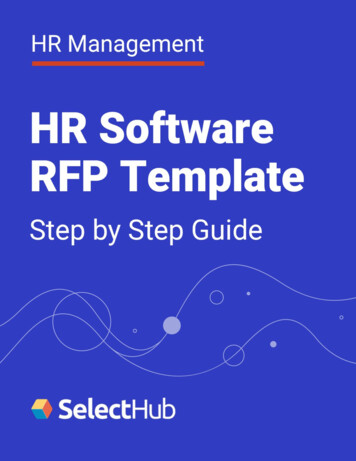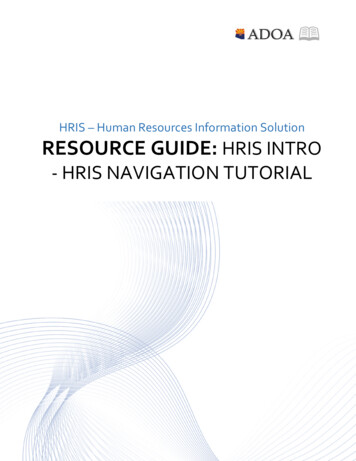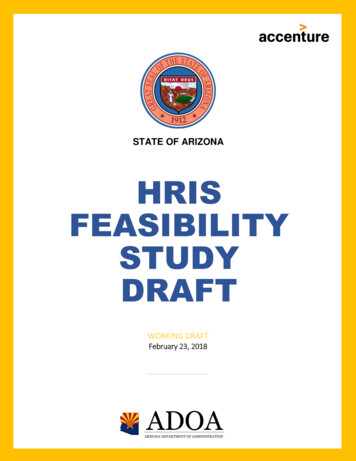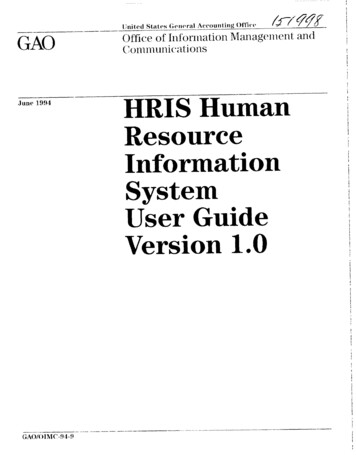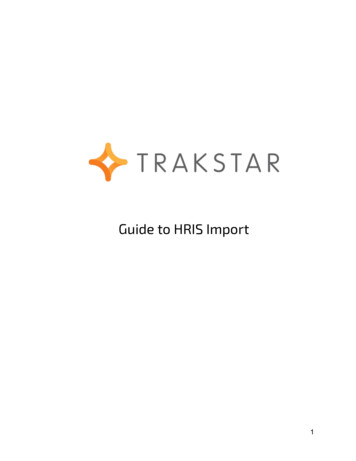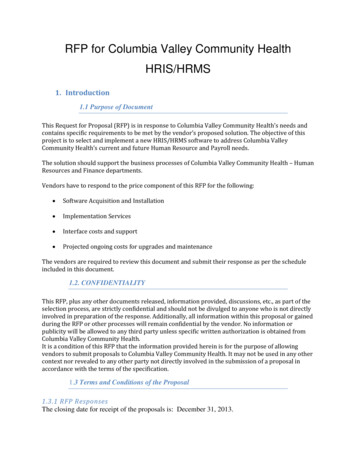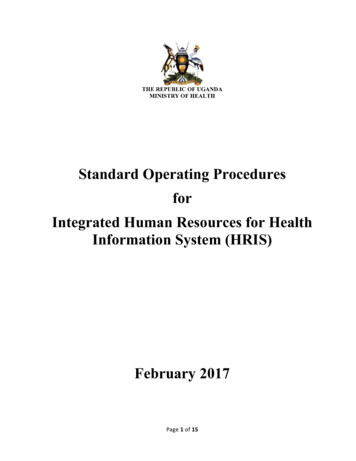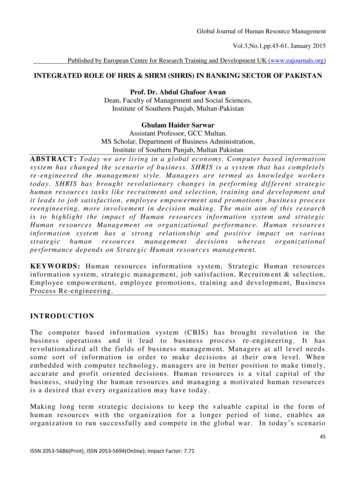
Transcription
Global Journal of Human Resource ManagementVol.3,No.1,pp.45-61, January 2015Published by European Centre for Research Training and Development UK (www.eajournals.org)INTEGRATED ROLE OF HRIS & SHRM (SHRIS) IN BANKING SECTOR OF PAKISTANProf. Dr. Abdul Ghafoor AwanDean, Faculty of Management and Social Sciences,Institute of Southern Punjab, Multan-PakistanGhulam Haider SarwarAssistant Professor, GCC Multan.MS Scholar, Department of Business Administration,Institute of Southern Punjab, Multan PakistanABSTRACT : Today we are living in a global econ omy. Computer based informationsystem has changed the scenario of business. SHRIS is a system that has completelyre-engineered the management style. Managers are termed as knowledge workerstoday. SHRIS has brought revolutionary changes in performing dif ferent strategichuman resources tasks like recruitment and selection, training and development andit leads to job satisfaction, employee empowerment and promotions ,business processreengineering, more involvement in decision making. The main aim of this researchis to highlight the impact of Human resources information system and strategicHuman resources Management on organizational performance. Human resourcesinformation system has a strong relationship and positive impact on variousstrategic human resources management decisions whereas organizationalperformance depends on Strategic Human resources management.KEYWORDS : Human resources information system, Strategic Human resourcesinformation s ystem, strategic management, job satisfaction, Recruitm ent & selection,Employee empowerment, employee promotions, training an d development, BusinessProcess Re-engineering.INTRODUCTIONThe computer based information system (CBIS) has brought revolution in thebusiness operations and it lead to business pro cess re-engineering. It hasrevolutionalized all the fields of business management. Managers at all level needssome sort of information in order to make decisions at their own level. Whenembedded with computer technology, managers are in better position to make timely,accurate and profit oriented decisions. Human resources is a vital capital of thebusiness, studying the human resources and managing a motivated human resourcesis a desired that every organization may have today.Making long term strategi c decisions to keep the valuable capital in the form ofhuman resources with the organization for a longer period of time, enables anorganization to run successfull y and compete in the global war. In today’s scenario45ISSN 2053-5686(Print), ISSN 2053-5694(Online); Impact Factor: 7.71
Global Journal of Human Resource ManagementVol.3,No.1,pp.45-61, January 2015Published by European Centre for Research Training and Development UK (www.eajournals.org)of knowledge based econom y, organizat ional success depends tremendousl y on theperformance of human resource management . Automation enabled with CBIS reducesthe amount of routine work that must be done, thereby providing more opportunitiesfor individuals to think and use their absolute cogn itive capacities. In Humanresources department , the automation of repetitive administrative activities, such aspersonnel reporting and record keeping, may allow professionals to spend less timeon administrative activities and more on interpreting inform ation. Furthermore,Human Resource Management (HRM) has recentl y turned its concentration onknowledge sharing and strategic workforce anal ysis and has been increasingl yevolving into a significant contributor to the organizational strategic management .Strategic value can be derived using HR IS tools that assist decision -makingconcerning vital HR functions . The subject of strategic significance of humanresource management in organizational tactics and model s gives a cavernous ventureinto one of the basic success factors that successfull y support the achievement ofleadership and objectives of management. This paper provides a depth study intoone of the major Component s of modern human resource management that isidentified as Human Resource Information System.The study is neither going to focus on various types of Computer software that aredeveloped for HRIS specific applications nor is concentrating on the computersoftware applications and HRIS software used in support of the system. Technologyis not itself a subject matter of this study, but the effect of technology basedinformation system (HRIS) and SHRM is studied over here. The practical impactthat HRIS and SHRM i.e. SHRIS exerts on the banks in Pakistan is observe d.LITERATURE REVIEWThrough HR IS employees are recruited, better working environment is made andmotivation is made, since their job assignments are clearl y defined and outlined. It isalso informed that what are the expected outcome, so we can say that it is gettingwork done. This leads to better performance and organization is in a good position toachieve its strategic goals. Paug (1986).Zuboff (1988) Within HR, the automation ofrepetitive administrative activities, allow professionals to spend less time onadministrative activities and more on interpreting information.Today we are living in a global econom y. There is a rapid change in businessenvironment and operations each day and even each hour. The Human resources aremainl y responsible for success of any business enter prise. Lippert & Swiercz (2005).Dessler & Al Ariss (2012), HRM helps human resources of an organization inperforming different process thus leads to an integration to overall strategy of anorganization. Competitive advantage can be attained by appl ying Strategic approachto Human resources and thus getting benefit from the abilities of People.46ISSN 2053-5686(Print), ISSN 2053-5694(Online); Impact Factor: 7.71
Global Journal of Human Resource ManagementVol.3,No.1,pp.45-61, January 2015Published by European Centre for Research Training and Development UK (www.eajournals.org)Business process reengineering has advocated that primary administrative personnelfunction is to be transformed into Modern Human resources and then Humanresources information system. Changing the shape of personnel function to Humanresources will provide a better results and ultimatel y lead to enhance organizationalperformance. Cooper (2011).The human resources information system function involves recruitm ent, placement,evaluation, compensation and development of the employees of an organization. Thegoal of HRIs is the effective and efficient use of the human resources of anorganization. James A O’ Brien (2005)HRIS is used to provide data to companies f or two purposes, one to make effectiverecruitment and secondl y for strategic decisions like retention and integrating withoverall corporate strategies. Karke connected industrial revolution with Informationtechnology revolution in terms of expected scop e and the effect on the econom y andsociet y. He called it digital economics and a Network Econom y. Three has beenthree waves of application of information technology to the business world and theselead to somewhat electronic strategic suppl y chain in th e end and much more isexpected. Kovach ( 2002)HRIS and SHRM are correlated on four policy goals, which are Strategicintensions, commitment , flexibilit y, qualit y Guest (2003) Ravi kalakota (2006)concluded that banks have a strong impact of Information technology, the speed andqualit y of service delivery has increased. Corporate Intranets have made HR capableof performing their work more easil y and in time results can be achieved. Ali Irshad& Shamas-ur-rehman Toor (2008) concluded that the human resources in Pakistan isnot well shaped. To retain and develop human resources there is the need of someinformation technology based system.M. Shaukat and Junaid Zafar (2010) developeda questionnaire. They found that organizations in Pakistan, especiall y S BP isutilizing HRIS in strategic decisions to its full potential at the time. Day by day theSBP is depending more on HR IS and thus its performance is increasing thereby.Hussain R & Javed M (2011) studied the impact of HR IS on strategic decision inbanks of Iran and concluded that HR IS has a major impact on decision making. Theydeducted that HR IS can be applied for making various strategic human resourcedecisions and HR IS in conjunction with strategic human management makes aremarkable difference in the performance of a bank.Emeka Smart (2013) studied the application of HRIS on Nigerian Banking sector.According to the study HRIS leads to successful organizational learning, substantialproductivit y and contributes towards overall strategy to enab le competitive edge.47ISSN 2053-5686(Print), ISSN 2053-5694(Online); Impact Factor: 7.71
Global Journal of Human Resource ManagementVol.3,No.1,pp.45-61, January 2015Published by European Centre for Research Training and Development UK (www.eajournals.org)Research Objective:The objectives of the study are to evaluate:1.HRIS support for strategic Human resource management2.Relationship between (HR IS) and (SHRM).3.Extent of HR IS involvement in SHRM decisions.4.Integrated effect of HRIS & SH RM on the performance of banking sector ofPakistan.5.Future of SHR IS in banking sector of Pakistan.Research gapDifferent studies have been carried on HRIS but these are just the case studies. Noneof the study has focused on intergraded impac t of HRIS and SHRM, especiall y inbanking sector. This study is the first attempt to evaluate the effect of SHRIS on theperformance of banking sector of Pakistan.Distinction of this study :his researcher has tried to find out the collective impact of Hu man resourcesinformation system and strategic human resources management decisions onperformance of banking sector of Pakistan.Conceptual Framework :Human Resources ManagementManaging the resources that are owned by an organization in a proper andappropriate way is the key to success. Human resources are an important constituentof the organization. In today’ global econom y HR are considered as integral andvital resources that are owned by an organization. HRM is also a strategic andcomplete approa ch to managing people and the workplace culture and environment.Successful HRM enables employees to contribute effectively and productively to theoverall company objecti ves track the achievement of the organization's goals andobjectives.Figure 1: Conceptual frameworkHRISSHRISPerformance of BanksSHRM48ISSN 2053-5686(Print), ISSN 2053-5694(Online); Impact Factor: 7.71
Global Journal of Human Resource ManagementVol.3,No.1,pp.45-61, January 2015Published by European Centre for Research Training and Development UK (www.eajournals.org)Figure 2: Study flow diagramHuman Resources ManagementManagement1- Operational HRISHumanResourcesinformationSystem2- Tactical HRIS3- Strategic HRIS4- Computer Based HRISStrategic Human Resources Information SystemIntegration between HRIS and SHRMIntegration between HRIS and SHRMImpact of HRIS on Strategic decisions:1.Business Process re-engineering 2. Recruitment & Selection 3. Union Management4. Employee Benefit analysis 5. Training & Development 6. Decision makingImpact of SHRIS on banking sector:(Non-financial factors as determinant of organizational performance)a.Job satisfaction. b. Employee promotionsc. Employee empowermentb.Professional standing d. involvement in decision makingFuture of SHRIs in banking sector of Pakistan49ISSN 2053-5686(Print), ISSN 2053-5694(Online); Impact Factor: 7.71
Global Journal of Human Resource ManagementVol.3,No.1,pp.45-61, January 2015Published by European Centre for Research Training and Development UK (www.eajournals.org)STRATEGIC INTEGRATIONStrategic decisions and results can be achiev ed by implementing HR IS Tools and italso helps in making decisions. Farndale (2010):HR Analysis : It means to determine HR needs of an organization. This functionmakes the organization capable of determining: what qualit y and quantit y ofpersonnel is needed, whether personnel are sufficientl y qualified and whether furthercapacit y is need?(Mayfield 2003)Personnel Development : Dessler (2013) describes that personnel development helpsorganization to decide that in which areas current personnel is not full y acquaint.Knowledge Management : HRIS also provides a way to organization learning byproviding a better mechanism of Feedback and Feedforward, intrabusinesscommunication and decision making.Communication & Integration: When all the information is sen d and received righton time and place employees are in better position to perform their duties.Forecasting and Planning : HR IS helps in determining workforce requirement andsuppl y by providing on time data on demand and suppl y .Records and Compliance : The record keeping also leads to a valuable contributionto knowledge management. (Mayfield, et al., 2003)TYPES OF HRIS :There are following types of HR IS: Operational, tactical and strategic.OPERATIONAL HRIS: Operational HRIS helps managers to perform dail y routinefunctions and facilitate concurrent decision making.Parts of Operational HRIS:Employee Information System : So HR IS aids to maintain a dynamic Database thatcontain information like Employee name, Address, qualifica tion, Sex, Marital Status ,work experience , years of Service and seniorit y etc.Positional Control Information System : The basic purpose of Position controls ystem is to identify each job, its title, classification and current status ofemployees. This system also guides about vacancy positions in an organization.Selection and Placement Information System : Pooling human resources,screening, placement and job orientation are all functions which are aided bySelection and placement information system. Performance Appraisal Sys tem : Thiss ystem includes documentation of employee performance, methods to measureperformance and reporting system are components of this system.TACTICAL HRIS : following decisions are facilitated by tactical HR IS :recruitment decisions, job anal ysis, job design, training, career development andcompensation50ISSN 2053-5686(Print), ISSN 2053-5694(Online); Impact Factor: 7.71
Global Journal of Human Resource ManagementVol.3,No.1,pp.45-61, January 2015Published by European Centre for Research Training and Development UK (www.eajournals.org)STRATEGIC HUMAN RESOURCESSHRM set new magnitude of Human resources and these a re attempted to meet globalchallenges and are quite different from traditional Human resources functions.SHRM is aimed at Improving work relationship, shaping Human resource policiesand practices with business requirements, giving proper importance to human capital,enable Human resources to adopt and change with themselves with Global changes.Scope of SHRM: Business process re -engineering, restructuring, workplace learning,union management relationship are some covered under SHRM.HRIS and SHRM Integration: Development of internet, e -business, changing natureof WWW has brought a flood of information and inn ovative management & businessmodels over the information superhighway. It is observed that SHRM is such aprocess that is aimed as designing, linking and implementing such HR practices thatlead to organizational long term a s well as short term objectives and HRIS is a toolthat facilitate to achieve various strategic HR objectives in a more delicate manner.SHRIS in Banking Industry:HRIS has changed banks’ financial as well as non -financial processes from manualto automatic computerized systems. In the very beginning, HRIS was mostl y used toprepare salary and other financial benefits regarding bank employees. But with thepassage of time HRIS was also used for non financial support like ommunicati on.AccordingtoPanayotopoulou (2007) there are several effects of technology on six key HRprocesses in banks, namel y: HR planning; Acquiring HR (recruitment andselection);HR evaluation (performance appraisal);Communication; Rewarding HR(performance ap praisal, compensation and benefits); and Developing HR (trainingand development, career management).RESEARCH METHODOLOGYSample: A questionnaire survey was developed and sent through postal system to 35different banking and financial institutions wor king in Pakistan. Response Rate :Out of 175, 155 questionnaires were returned having response rate of 88%. In all 1 7questions were used.Sampling Technique: The study uses non-probabilit y sampling technique in whichdata was obtained on the basis of co nvenience.Data and Types of Data: Primary data has been used in this study.Data collection Procedure: Primary data is used in this study, which is collectedthrough sending of questionnaire to different banks and financial institutionsworking all over P akistan.51ISSN 2053-5686(Print), ISSN 2053-5694(Online); Impact Factor: 7.71
Global Journal of Human Resource ManagementVol.3,No.1,pp.45-61, January 2015Published by European Centre for Research Training and Development UK (www.eajournals.org)Dependent and Independent Variables : Dependant variables are Integrated Humanresources information system (HR IS) & Strategic human resources management i.eStrategic human resources information system (SHR IS) and organizationalperformance. While Business process re -engineering, Union management relations,Recruitment and selection, employee benefit anal ysis, training and development ,decision making ,job satisfaction, employee empowerment, involvement in decisionmaking, employee promotion, pro fessional standing are included as independentvariables .BPR,R&S,UM,EB,TD, DMDM ,JS, EP,EPr, EPSHRISOrganizationalperformanceFigure 3: VariablesWhere BPR Business process re -engineering, R & S Recruitment & selection,Um Union management relations, EB Employee benefits, TD Training &development, DM Decisi on making, Js Job satisfaction, EPr Employee promotions,EP Employee empowerment, EPS Employee professional standingData analysis techniques: The study used two t ypes of techniques:1.Descriptive analysis 2.Quantitative analysist-tests, Correlation analysis and Regression analysis.Formulation of Hypotheses : The study is aimed to find the integrated (combined)role of HR IS and strategic human resources management in banking sector ofPakistan. So w e framed the following hypothesis: HYPOTHES IS:H 1 HRIS is used in support of making Strategic decisions in Banking sector inPakistan.H2 There is a positive and significant relationship between HRIS and SHRM asis used in Banking sector in Pakistan.H 3 :HRIS effects the basic SHRM functions in banking sector of Pakistan.52ISSN 2053-5686(Print), ISSN 2053-5694(Online); Impact Factor: 7.71
Global Journal of Human Resource ManagementVol.3,No.1,pp.45-61, January 2015Published by European Centre for Research Training and Development UK (www.eajournals.org)The hypothesis is analyzed using regression analysis, evaluating individualpredictorsH 1 3(a) : There is positive and Significant relationship between HR IS and Businessprocess re-engineering.H 1 3(b) : There is positive and Significan t relationship between HRIS and training &development.H 1 3(c) : There is positive and Significant relationship between HRIS and Employeebenefit anal ysis.H 1 3(d) : There is positive and Significant relationship between HRIS and UnionManagement relations.H 1 3(e) : There is positive and Significant relationship between HRIS and trainingand development.HRIS Human resources information system. ;BPR Business process re engineering ; R& S Recruitment & Selection ; UM Union & Management ; EB Employees Benefit AnalysisTD Training & Development ; DM Decision makingEstimation MethodWe used two methods to estimate the parameters.1. A five (5) point likert scale. 2. Econometric technique.2. We explain our econometric Model as under:Economic model:HRIs function (BPR RS UM EB TD DM)A regression model is also built as follows:HRIS β β1(BPR) β2(RS) β3(UM) β4(EB) β5(TD) β6 (DM).H 4 Use of Integrated SHRIS willBanking sector.lead to improved performance in PakistanH 4 Integrated HR IS and SHRM has positive and significant effect on performanceof Pakistan’ Banking sector.Studying various social indicators(non-financial factors) under regression analysis, the hypothesis isanalyzed as under:H14(a) : There is positive and significant relationship between SHRIS and job satisfaction.H14(b) : There is positive and significant relationship between SHRIS and employee empowerment.H14(c) : Integrated SHRIS has positive relation with strategic decision making.H14(d) : Integrated SHRIS has positive relation with employee promotions.H14(e) : Integrated SHRIS has positive relation with employee promotions.A regression analysis is conducted with the following regression model:Org performance β β1 (Decision involvement) β2(Job satisfactoin) β3(Employ empowerment) β4(Employee Promotions) β5 (Employee Prof.standing)53ISSN 2053-5686(Print), ISSN 2053-5694(Online); Impact Factor: 7.71
Global Journal of Human Resource ManagementVol.3,No.1,pp.45-61, January 2015Published by European Centre for Research Training and Development UK (www.eajournals.org)It can also be expressed as :Org Performance function (DM JS EP EPr EPS)Org Performance β β1(DM) β2(JS) β3(EP) β4(EPr) β5(EPS)Where DM Decision making; JS Job satisfaction ; EP Employee empowermentEPr Employee promotions; EPS Employee professional standingH 5 HRIS will have more useful involvement in strategic human resourcesdecisions in Banking sector of Pakistan.EMPIRICAL ANALYSISSince the support of statistical package SPSS was available therefore t -test was usedinstead of sample size of more than 30, a critical region of 3 is hypothesized.Human Resource Accounting : In 1967 Likert, suggested that financial utilit y ofdifferent HR functions must be measured. In 1965, Cronbach & Glaser and Naylor &Shine developed different modes for determining and evaluating financialeffectiveness of selecting personnel using concept of utilit y anal ysis.Problem of reporting : According to Turner (1996),Human resource accounting wasdiscussed for the first time some 30 years ago. There is two main problems thatrestricted it from emerging as a part of financial accounting because employee don’tqualify as Assets and there is no justifiable system of reporting questions like whatshould be measured, for whom? Why?Use of Social indicators (performance indicators) to evaluate the Organizationalperformance: Different researchers grouped t he non-financial measures into fivegeneral categories: cus tomer service, market performance, innovation, goalachievement, and employee involvement. The results of the study showed thatcustomer service factors are perceived to be the most important measures, includingsuch factors as “customer satisfaction,” del ivery performance/customer service” andproduct/process/service qualit y. Human Resources Indicators includes involvementin decision making, empowerment, job satisfaction, training & development, unionmanagement relations and employee professional standi ng.EMPIRICAL RESULTSCronbach alpha is above 70 percent showing reliabilit y of scale measurement. Themeasure shows that variables are internally consistent.Hypothesis 1 & 2In both cases the calculated mean value is above than our hypothesized value of 3, therefore, itis inferred that HRIS can be applied and is used in banking sector of Pakistan & there is apositive and strong relationship between HRIS and SHRM.54ISSN 2053-5686(Print), ISSN 2053-5694(Online); Impact Factor: 7.71
Global Journal of Human Resource ManagementVol.3,No.1,pp.45-61, January 2015Published by European Centre for Research Training and Development UK (www.eajournals.org)Hypothesis 3 & 41. There is complete correlation between dependant variables which is sh own incorrelation matrix . (Table 6 & 8 )2. The model is capable of explaining the variables. Since the level ofsignificance in each case is less than 0.05, therefore, the model is significant,the research model is accepted at p 0.05 significance level. T herefore, there isstatisticall y significance impact of HRIS on various strategic human resourcesfunctions. Moreover, there is statistically significance impact of SHRIS onorganizational performance.3. The impact of individual independent variables on dep endent variables aredepicted by Coefficient “B”(estimated coefficient). Because all the values inboth hypothesis are less than 1, therefore, the estimated value “B” are true andcoefficient of estimate is reliable.4. Moreover, all values in Column “B” sho wing estimated coefficient liesbetween upper and lower bounds of confidence level, therefore, coefficient ofestimate is reliable and satisfactoril y significant.(Table 4&7)5. None of the variables is creating multi -colliniarit y problem since R 2 is lessthan 75 % in each case.6. t and sig. (which is known as p -value)values, in above table, give a roughindication of each predictor variable (Kumar, et.al 2010). A big absolute tvalue and small p value suggested that a predictor variable is having a largeimpact on the criterion variable. A large value indicates that a unit change inthis predictor variable has a large effect on the criterion variable. InHypothesis 3 ,Business process re -engineering with β value of 2.590 emergesas the strongest predictor for HR IS. Since it has a large “t” value and small“p” value. In Hypothesis 4 , The strongest predictor for SHRIS is strategicdecision making followed by job satisfaction.7. Since β also falls between upper and lower limit, therefore we can layconfidence.8. Since in all cases (from H 3 a to H 3 e) and (H 4 a to H 4 e) the calculated F value isgreater than tabulated F value (Table 5), therefore we reject the nullhypothesis.The findings in hypothesis 3 showed that Business Process re -engineering is the mostimportant indicators showing the effects of HRIS in making strategic humanresources decisions banking sector of Pakistan. The results is very obvious since theBusiness Process re -engineering is the concept that has given the banking sector anew shape and enabled th e managers to make timel y decisions and effectivel yadminister their Human capital.The findings showed that participation in strategic decisions and job satisfaction arethe two most stronger and importance indicators of SHR IS in banking sector ofPakistan. The results are compatible with the fact that decision making and job55ISSN 2053-5686(Print), ISSN 2053-5694(Online); Impact Factor: 7.71
Global Journal of Human Resource ManagementVol.3,No.1,pp.45-61, January 2015Published by European Centre for Research Training and Development UK (www.eajournals.org)satisfaction are considered to be the main components of human resourcesmanagement.It is quite evident from the above findings that there is a strong impact of HRIS onstrategic Human resources management decisions and there is complete integrationbetween these two concepts and applications, it is inferred that their integrationwill bring a good and pleasant change in the organization that shall lead towardscompetitive advanta ge.The findings showed that participation in strategic decisions and job satisfaction arethe two most stronger and importance indicators of SHR IS in banking sector ofPakistan. The results are compatible with the fact that decision making and jobsatisfaction are considered to be the main components of human resourcesmanagement.Finally in hypothesis 4, it is concluded that from above discussion that variousnon-financial determinants of organizational performance shows that HRIS andSHRM together (SHR IS) affect the performance of the banks.Hypothesis 5:Since calculated value lies in between upper and lower limit and is above thanthe hypothesized value (3), so the study has no grounds to accept Nullhypothesis and it is inferred that SHRIS has a st rong and bring future in thebanking sector of Pakistan.CONCLUSIONThe empirical results show that HRIS and SHRM together, play an important role inincreasing the performance of banks. The study also concludes that various SHRMtasks in banks like Business process re-engineering, healthy union relations,determination of management employee relations, training and development,participation in decision making has a strong relationship with HRIS. They studyconcludes that HR IS is a technology that sh all bring more benefits to the bankers andgive the organizations a new and better look.RECOMMENDATIONSHRIS becomes a progressivel y more critical factor with SHRM tasks. Researchersmust increase their work to comprehend the chances and hazards in im plementingSHRIS.56ISSN 2053-5686(Print), ISSN 2053-5694(Online); Impact Factor: 7.71
Global Journal of Human Resource ManagementVol.3,No.1,pp.45-61, January 2015Published by European Centre for Research Training and Development UK (www.eajournals.org)LIMITATIONSThe study is based on existing scenario of HR IS, and may not be able to cope withrapid changes in technology. Questionnaire saves cost but it is exposed torespondent’s bias and mood .SCOPE FOR FUTURE RESEARCHHRIS is an emerging concept. A much more work can be done on thetechnological aspects of HRIS. Pure Quantative research can also be carried outto find the impact of HRIS on the financial performance of banks.Finally, integration of SHRIS with overall strateg y of the organization can also bestudied.Tables of Empirical ResultsTable 1 Reliability StatisticsCronbach's Alpha Cronbach's Alpha Based on Standardized Items.777N of Items.77816Table 2 One Sample Statistics (Hypothesis 1,2 and 5)Does HRIS be applied in making Strategic HRdecisions?Is a relationship exists between HRIS & SHRMWhat is the future of HRIS in strategic human resourcesdecisions in banking sector of Pakistan?NMeanStd.DeviationStd. 11553.9613.92501.07430Table 3 One-Sample Test (Hypothesis 1,2 and 5)TDf51.370154.0003.795163.64923.941152.541154.
utilizing HRIS in strategic decisions to its full potential at the time. Day by day the SBP is depending more on HRIS and thus its performance is increasing thereby. Hussain R & Javed M (2011) studied the impact of HRIS on strategic decision in banks of Iran and concluded that HRIS has a major impact on decision making. They
